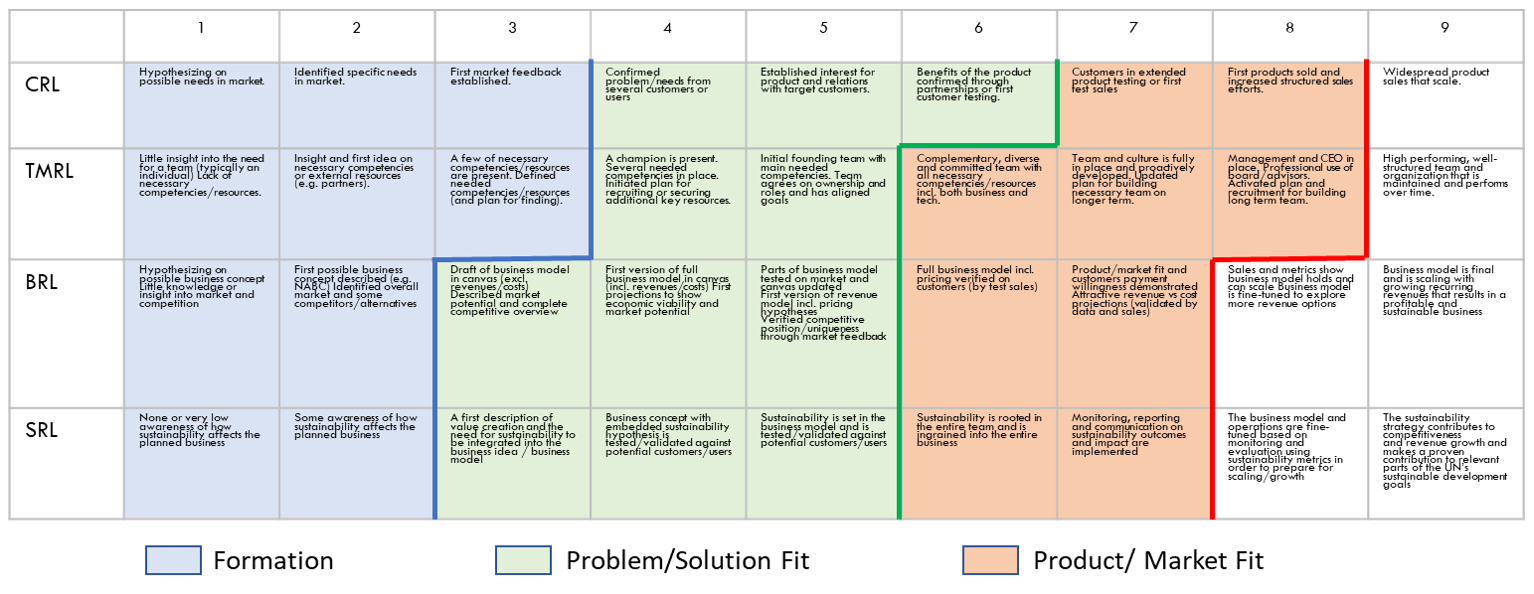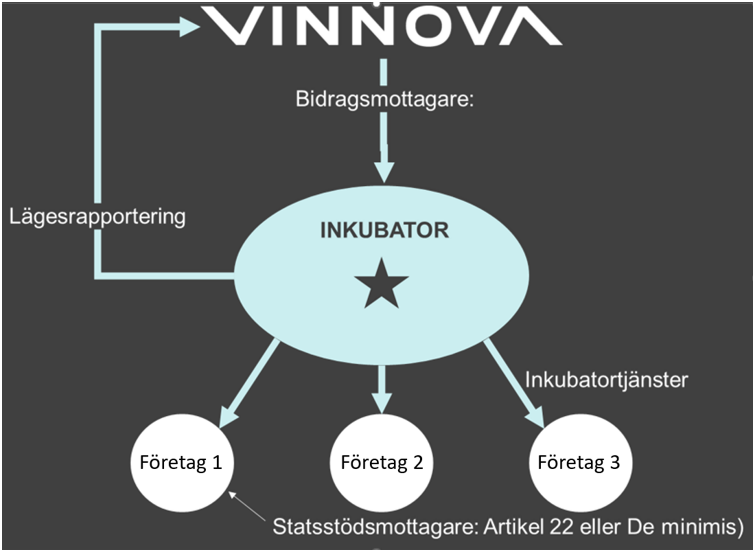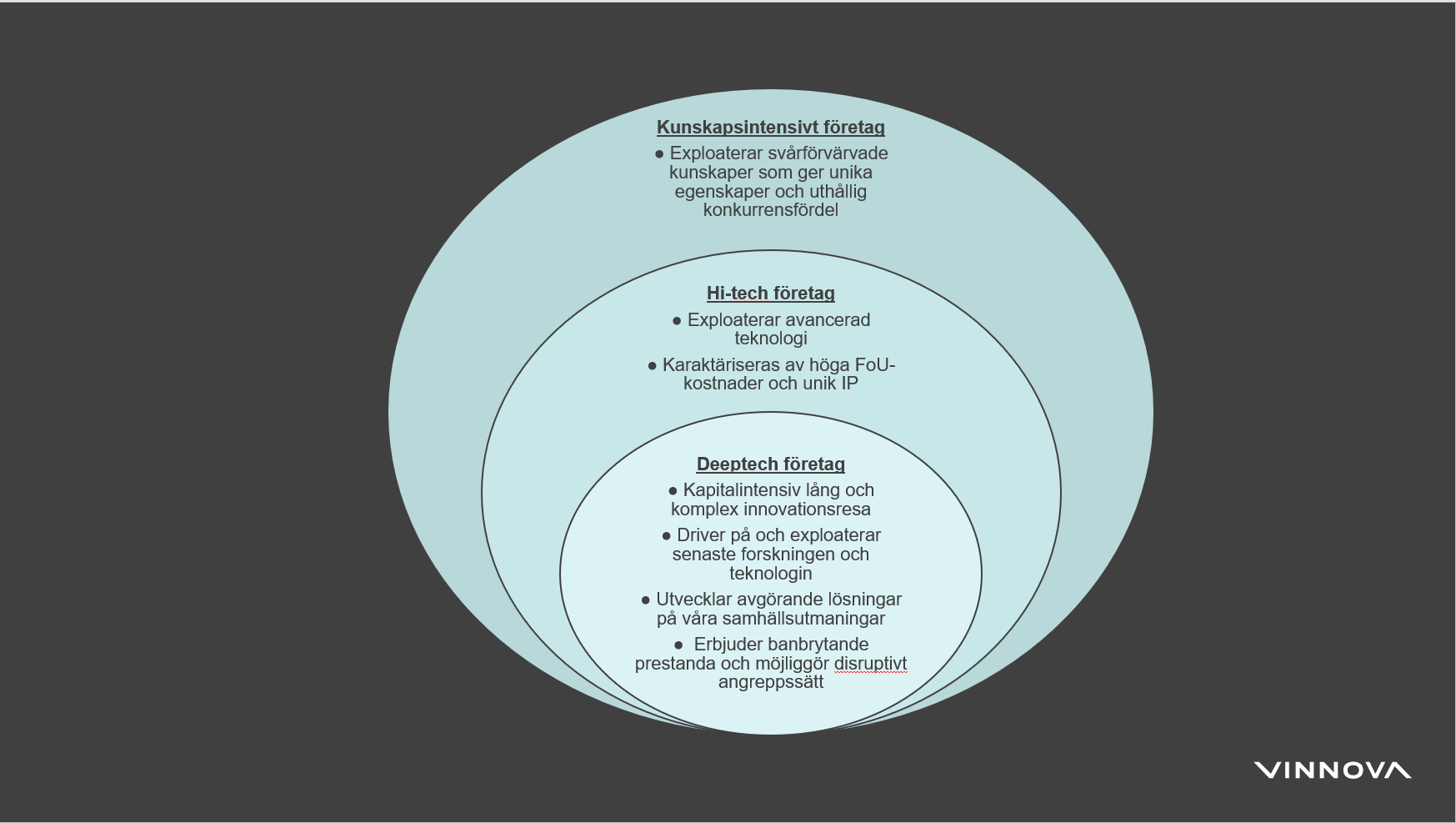The call for proposals is divided into two stages:
- Step 1: In the first step in the spring of 2024, which incubators meet Vinnova's eligibility requirements in terms of quality in activities and processes are evaluated. The incubators that meet the call's eligibility requirements will be included in Vinnova's national incubator program and will be eligible to apply in step 2 of the call.
- Step 2: The incubators that reach the quality requirements during step 1 will, in autumn 2024, complete their proposal from step 1 by submitting 15 companies from their business portfolio for assessment. The funds that the incubator can receive within this step are based on the combined score that the incubator's business portfolio generates during the evaluation. More information on how this will be done will be presented later for the incubators that are offered to apply within stage 2.
Maturity of companies during incubation
To define a business idea or a company's maturity and progress during the time that the company is in incubation, the following four "Innovation Readiness Levels (IRL)" from KTH's IRL model are used:
- Customer Readiness Level (CRL)
- Business Readiness Level (BRL)
- Team Readiness Level (TMRL)
- Sustainability Readiness Level (SRL)

Figure 2 shows the description of a company's innovation journey and maturity:
Here the four development phases are described from the point of view of the company's maturity in terms of the selected IRL scales. Formation (blue field), Product market Fit (green field), Problem Solution Fit (red field) and the white field which means that from Vinnova's point of view the company has passed the exit for Vinnova's incubation means.
Se KTH website for detailed information for each box
The journey from early business ideas to near commercialization
The purpose of Vinnova's funding during stage 2 is to:
- Give the applicant the opportunity to conduct formation of new companies.
- Give the applicant the opportunity to conduct incubation of inducted companies.
By "formation" Vinnova refers to the incubator's work in moving innovators, entrepreneurs and start-up companies in terms of maturity so that all four IRL characteristics cross the dark blue line as shown in the figure above.
Overall, this means that:
- Guide around relevant sustainability perspectives, including sex and gender perspectives, in business development.
- Support them in the work of forming relevant and equal teams based on representation and influence.
- Help the team determine the appropriate commercialization strategy and next steps. The goal is for them to have done an initial validation of Problem- Solution Fit. That is, assess the conditions for being able to be better than the customers' current alternatives and how that business can be scaled up. Furthermore, determine the conditions for the next step in the chosen strategy.
- Develop and determine the conditions and suitability to later bring the team or business idea into incubation.
By incubation, Vinnova refers to the incubator's work in green (Problem solution fit) and red (Product market fit) according to Figure 1 above. Incubation formally begins when all the IRL properties have reached the blue line according to Figure 2.
Incubation means that the incubator has the following processes defined and implemented:
- Selection
That is, how the incubator ensures that the company that is taken into incubation meets Vinnova's target group criteria. See under the heading Target group criteria below. - Eligible
To ensure that the company is entitled to support from Vinnova. See under the heading Target group criteria below. - Business Development
How does the incubator during the incubation period during the incubation period ensure and quality assurance that a company meets the criteria for Vinnova's target group for stage 1 of the call for proposals. And that the incubator has access to networks that give companies relevant access to capital, customers and skills. - Exit
In what way does the incubator decide when and how the incubation support is interrupted.
Exit can take place either when the incubator judges that the company has successfully reached a state where incubation should end ("positive exit").
Exit can also take place when the incubator judges that the conditions for commercial success cannot be ensured and the incubation should be discontinued ("negative exit").
At the time the incubator agreement is signed, all 4 IRL characteristics must be within the maturity levels for problem solution fit.
Target group criteria for our funding within step 2
Within the national incubator programme, Vinnova finances business development in new and knowledge-intensive growth companies. The company's business concept must be scalable, sustainability-driven and have potential to solve challenges in society or the economy. The business ideas that are developed need, in order to have a long-term competitive advantage, to have potential to create unique intangible assets.
The funds that Vinnova grants during stage 2 of the call for proposals must be used to support companies that meet or are expected to meet the following target group characteristics:
- The company admitted to the incubator must be a start-up company, not an established company.
- The company must be eligible to receive state aid.
- The company's must be founder-owned and founder-run, where the founding team shows a sufficient level of commitment to ensure the progress of the company's development.
- The value proposition on which the company's establishment in the market is based is innovative, that is, it offers an innovative customer value that is significantly different from other alternatives in the market being addressed.
- The company must have a sustainability-driven business that solves a challenge in society or the economy.
- The value proposition has the potential to be significantly better than competing solutions in the market it addresses.
- The company has the conditions to develop a scalable and profitable business based on the value proposition.
- The company has unique intangible assets that give the company the conditions to create a sufficient time lead and attractiveness to reach the market on time.
- The company is not market-ready, that is, it does not have repeatable sales or an equity that ensures the company's activities for 24 months or more.
Within the target group of knowledge-intensive companies, during the funding period 2025–29, companies in hi-tech and deep-tech must be prioritized. See Figure 1, Chapter 3.
Under the call text's appendix " Special conditions and instructions" there is an in-depth description of target group criteria and rules for how Vinnova's funding is to be used.
Basis for support
Vinnova's funding takes place through funding. Funding for organizations that carry out economic activities is covered by rules on state support. The rules govern, among other things, which types of costs and how much of them may be covered by funding.
Read more about government support
See general terms and conditions for funding and guide for eligible costs
Within the framework of this call for proposals decided funding for the incubator must be translated into services at the companies that the incubator supports during the program period. This means that it is the companies that are the recipient of the state aid, see figure 3.
The companies that are offered the incubator's services must meet the requirements for state support according to one of the two support bases below:
- According to article 22 of Kommissionens EU-förordning no. 651/2014 of 17 June 2014, also known as the general group exemption (GBER), and section 12 of the regulation (2015:208) on state support for research, development and innovation.
- In case the company is not counted as a start-up company according to Article 22, the support is instead given as the minimum to the company according to Kommissionens EU-förordning no. 1407/2013 on support of minor importance.
Description of figure 3 below:
The incubator beneficiary. The companies that receive the incubator's services become state aid recipients.

The services must be offered to the companies according to pre-established criteria in a transparent and non-discriminatory manner. Elements of subjective or otherwise improper selection methods must not occur.
The value of the state aid imposed on the company must be based on the market price of the service or on the incubator's own costs to deliver the service plus a reasonable mark-up. The cost price plus the mark-up must then correspond to the market price.
The costs must be made public so that a company, as a user of the incubator's services, knows the size of the support and that it becomes transparent.
Eligible costs
Under section Basis for support it is described that the companies that receive the incubator's services are the recipients of the state support, not the incubator.
For the support that Vinnova decides on during step 2 eligible costs are defined as the costs the incubator has to deliver services to the companies within the incubator. The costs can be incurred through internally generated services or externally procured services.
The costs of services that can be reimbursed are:
- Develop the company and its business through:
Business coaching, recruitment and team building, access to networks and capital, law, communication, IP strategies, design, expert services in connection with verifying business ideas, purchasing market studies, trainings that strengthen operational implementation such as sales, board work and business development. - Support for marketing activities:
Travel expenses and participation fees to fairs, customer and partner meetings, capital provision. - Use of infrastructure:
Costs for using investments in infrastructure such as office space, access to a test or lab environment, IT or infrastructure.
The costs that the incubator reports to Vinnova must be real and auditable.





